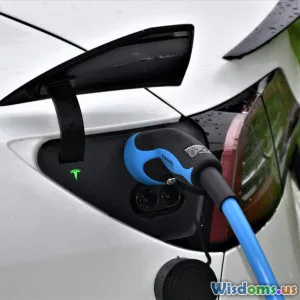
Unexpected Route Optimization Features That Save You Fuel
8 min read Explore little-known route optimization features that dramatically cut fuel consumption and improve efficiency for drivers and fleet managers. (0 Reviews)
Unexpected Route Optimization Features That Save You Fuel
Fuel costs often represent one of the top expenses for individual drivers and fleet managers alike. As fuel prices fluctuate and environmental concerns heighten, efficient fuel use isn’t just good economics — it's an essential responsibility. While many are familiar with basic fuel-saving tactics like choosing the shortest path or avoiding traffic jams, there are some lesser-known route optimization features that can substantially reduce fuel consumption. These insights unlock new possibilities for both personal drivers and logistics professionals to cut costs and decrease emissions.
The Pitfall of Conventional Thinking in Route Planning
Most traditional GPS or route planning tools prioritize shortest distance or fastest time routes. However, these metrics don’t always translate into fuel economy. For example, a faster route through heavy stop-and-go urban traffic may burn more fuel than a slightly longer route on open, steady-speed roads.
This discrepancy arises because fuel consumption is influenced by multiple factors beyond just road length or time: vehicle acceleration and braking, elevation changes, road surface conditions, and even micro-routing around localized obstacles.
To truly minimize fuel usage, route optimization must consider a richer dataset and apply sophisticated algorithms that tailor the path creatively.
1. Micro-Route Adjustments: Small Turns, Big Fuel Savings
Micro-route adjustment is an advanced feature where the route is tweaked at fine granularities to avoid inefficient driving behaviors — like unnecessary stops, sharp turns, or repeated braking
How Micro-Route Adjustments Work
Imagine driving through a commercial district filled with multiple stop signs and traffic lights. Instead of sticking to the default straight-line route, micro-route optimization might reroute you via side streets, adding insignificant length but eliminating multiple stop points.
These small detours allow vehicles to maintain more consistent speeds, significantly cutting fuel used during repeated acceleration phases. According to studies from the U.S. Department of Energy, aggressive acceleration can increase fuel consumption by up to 40% in city driving.
Real-World Example
A logistics company operating in San Francisco integrated micro-route adjustments in their routing software. Even though some routes increased mileage by less than 5%, average fuel consumption decreased by 7% due to smoother driving patterns and fewer stops.
2. Elevation-Based Routing: The Hidden Influence of Terrain
Many routing algorithms overlook the impact of terrain on fuel consumption, focusing predominantly on distance and time.
Why Elevation Matters
Fuel economy declines when vehicles must climb hills, as the engine works harder against gravity. Conversely, carefully selected downhill segments allow fuel-efficient coasting or regenerative braking in hybrid/electric vehicles.
By incorporating elevation data, routing software can optimize routes to minimize prolonged steep climbs or strategically use downhill stretches.
Data-Driven Insights
- Research by the National Renewable Energy Laboratory (NREL) demonstrated that accounting for elevation changes in route planning can reduce fuel consumption by approximately 5-8% on hilly routes.
- In particular, delivery fleets in mountainous regions using elevation-based routing report notable savings and less engine strain.
Case Study
A courier service in Denver began using elevation-aware route optimization software which prioritized routes with fewer steep ascents. While some trips added a marginal 2–3 miles, overall fuel savings averaged 6% per vehicle per month.
3. Dynamic Traffic-Based Rerouting: Beyond Traditional Traffic Data
While most navigation apps incorporate standard traffic conditions, advanced route optimizers exploit real-time and even predictive traffic analytics.
What Makes This Feature Unexpected?
Rather than just avoiding congestion, dynamic rerouting algorithms analyze traffic patterns at a micro-level—including the frequency of traffic light cycles, local event impact, and historical congestion spikes.
This permits:
- Avoidance of segments prone to random stop-and-go cycles
- Utilization of lesser-used parallel routes even if longer
- Timing trip start/end times with traffic patterns
Evidence of Impact
A study performed on urban delivery routes in Chicago found that integrating predictive traffic data into route optimization decreased fuel consumption by 10%, mainly thanks to avoiding inefficient fuel-wasting conditions rather than just cutting travel time.
4. Economical Speed Optimization: Pace Makes Perfect
Speed limits don’t equal fuel-efficient speeds. Cars typically achieve optimal fuel economy at moderate speeds (around 50-60 mph for many vehicles).
How Speed Optimization Saves Fuel
Route optimization can suggest cruising speeds along various segments to maximize fuel efficiency corresponding to traffic, road grade, and vehicle type.
The system dynamically balances time constraints and fuel economy, resulting in marginally longer trips but decreased overall fuel consumption.
Supporting Data
Studies reveal that driving at 65 mph rather than 75 mph can save up to 15% fuel on highway trips. Advanced optimizers use these findings to modulate pacing recommendations based on real-time traffic and target arrival times.
5. Integration of Multi-Modal Transport and Waypoint Complexity
Sophisticated routing systems consider not only vehicle destination but also integrate stops, pickups, and drop-offs in an order that optimizes fuel use.
The Role of Waypoint Optimization
Minimizing backtracking and avoiding redundant trips makes a surprising difference. Key features:
- Clustering close waypoints
- Sequencing deliveries to reduce exponential mileage
- Integrating multi-modal options like park-and-ride or public transport segments
Practical Example
Last-mile delivery companies using complex waypoint optimization algorithms reported as much as 12-15% reduction in fuel costs when rearranging delivery sequences and employing combined routing strategies.
Conclusion: Fuel Savings Lie in the Details
In fuel management, knowledge and tools that unlock efficiency beyond simplistic route shortcuts deliver the greatest impact. Micro-route adjustments, elevation-aware pathfinding, dynamic traffic prediction, speed optimization, and intelligent waypoint sequencing provide unexpected yet powerful opportunities to drive less and save more.
As fleets transition toward sustainability goals and cost pressures intensify, adopting these nuanced features isn't optional—it becomes critical to maintain competitive edge, increase profitability, and promote environmental stewardship.
Actionable Takeaway: If fuel efficiency matters to you, upgrading to routing solutions that incorporate these unexpected optimization features could reduce fuel consumption by double-digit percentages, translating directly into financial and ecological benefits that add up mile after mile.
Fuel-saving isn't just about shorter distances — it's about smarter routes and smarter choices.
Rate the Post
User Reviews
Popular Posts


















